Draw a Picture of Yourself Learning Math
What Pre-Service Teachers' Self-Portraits Illustrate About Their Complex Relationship With Mathematics
Samantha Sommers; Michelle Unigarro; Danielle Vantassel; Claudia Bertolone-Smith, Ph.D.; and Alison Puliatte, Ph.D.
Abstract
The purpose of this study was to examine factors that may influence pre-service teachers’ relationships with mathematics. Elementary pre-service teachers who were enrolled in a mathematics methods course (n = 52) wrote a letter to math and drew a picture of themselves learning math. The self-portraits were analyzed by a team of undergraduate student researchers and teacher educators to identify themes related to the types of emotions, experiences, and situations displayed. The results of the self-portrait analysis indicated a higher percentage of negative emotions as compared to positive and neutral emotions. Additionally, the portraits indicated the influence of early elementary experiences on developing the participants’ math identity and relationships with mathematics. Implications for teacher preparation coursework and elementary mathematics pedagogy are discussed.
Keywords: pre-service teachers; math methods, math anxiety, math identity
Introduction
Many pre-service teachers (PSTs) enter math methods courses with trepidation and anxiety, and this can be a result of their past experiences with learning mathematics (Brady & Bowd, 2005). To investigate this phenomenon, elementary PSTs (n = 52) in a math methods course were asked to write a letter directly to “Math”. This was done to personify the discipline of mathematics to elicit a personal reflection of the PST’s relationship and opinion about math
(Zazkis, 2016). To supplement the letter to “Math”, PSTs were also asked to draw a picture of themselves learning math and provide a caption explaining what was happening. The professors of the methods course encouraged their students to write honestly and to create a true selfportrait of a learning experience with math. Some students typed their letters, while others wrote them out by hand. Some students took pictures of themselves showing their reactions to math (i.e. crying, or excitedly working on a math problem) or they drew pictures. There was room for expression which provided a spectrum of emotions, perspectives, and experiences revolving around learning mathematics. This assignment aimed to uncover the experiences that PSTs had while learning math and their current attitudes towards math.
This was part of a larger study which analyzed both the letters and the self-portraits. Our study examined the perspectives and relationships which emerged in the self-portraits. The research and analysis presented in this article was conducted by three teacher-education students who were also research participants. Our positionality in doing this work was to acknowledge our own mindsets about math, while simultaneously investigating our peers’ responses. We found that because we are of the research group, we could rely on our funds of knowledge about our peer group. We also sought to know more about becoming better math teachers in the future, and this project helped shed light on this goal.
Literature Review
PSTs’ relationship with math can be attributed to a variety of factors related to their past experiences learning math. In this literature review, we discuss math anxiety, motivation, and instructional practices. Math anxiety and anxiety about teaching math in PSTs and in-service teachers can impact instructional choices and student achievement (Hadley & Dorward, 2011). PSTs can be hesitant about math content and methods courses depending on their past experiences learning mathematics. Pedagogical choices made by their teachers may have had a positive or negative impact on the PST. Motivation to persevere in learning mathematics requires teachers to carefully consider how to best accomplish this (Gojak, 2013). Instructional practices in mathematics are relevant in this case because PSTs are both impacted by the conditions in which they learned mathematics and are also learning to be mathematics teachers. Math anxiety, motivation, and instructional practices are a key part of understanding PSTs’ perspectives on mathematics.
Math Anxiety
Math anxiety is present when feelings of tension and self-doubt interfere with the ability to work with numbers and solve problems. Math anxiety can cause one to forget what they know about math and lose self-confidence (Tobias, 1993). Perspectives and relationships with math are first formed in early childhood. Negative experiences involving math can lead to the early development of math anxiety and greatly hinder working memory (Mutlu, 2019). Math anxiety can occur in the primary grades and peak in middle school or early high school, but its effects can remain well into adulthood and affect the quality of teaching from elementary teachers (Schubert, 2019). Elementary teachers can pass on negative perspectives of math if they experience math anxiety as well. Math anxiety is prevalent in PSTs, impacts their confidence in their abilities, and is correlated with a lack of self-confidence when teaching math (Karunakaran, 2020). Past research has identified that elementary PSTs, especially women, demonstrate high levels of math anxiety (McGlynn-Stewart, 2010; Stoehr & Olson, 2015). PSTs’ previous educational experiences as well as their parents’ outlook toward math impact the PSTs’ selfconfidence and ability to teach mathematics (Karunakaran, 2020).
There are steps that teachers and schools can take to lessen math anxiety for themselves and their students. One step is to adopt a variety of pedagogical approaches to teaching mathematics. For example, instead of relying primarily on lectures and notetaking in math lessons, teachers can position students as active rather than passive learners (Spikell, 1993).
Math can be made relevant to students’ lives and students can be encouraged to explore, conjecture, and propose solutions rather than engaging solely in rote learning of math rules and procedures (Small, 2019).
Student Motivation
Students are often blamed for lacking motivation; however, teachers can examine their pedagogical approaches to understand why students may lose their curiosity and initiative during mathematics learning (Gojak, 2013). For example, if the goals of learning mathematics shift from being curious about content and their environment to finding the right answer, motivation may decrease. Additionally, fostering a competitive environment during math instruction (i.e. posting student scores in public, praise focused on being fast, timed tests with reward systems) can increase stress and lessen motivation (San Giovanni et al., 2020). Teachers can encourage persistence and positive motivation in the classroom by providing activities that are challenging, allowing more time to complete tasks, carefully selecting classwork and homework assignments, and occasionally allowing students to choose assignments (Boaler, 2016). By encouraging students to be intrinsic motivators, math becomes less of a task and more of an exploration (Gojak, 2013).
The way a teacher presents materials and reassures a student that they are capable of learning and carrying out a task affects the student’s self-efficacy. Teachers need to foster students’ self-efficacy to help improve performance (Rongrong & Singh, 2018). Students’ selfefficacy, positive mindset, and intrinsic motivation can be increased when engaged in creative tasks (Du et al., 2019). Using creative tasks with math can motivate students to put more effort into completing activities they find challenging (Du et al., 2019)
Instructional Practices
Math can be presented as a creative task by using multiple modalities to meet the needs of all students. Math learning falls into two categories, auditory sequential and visual spatial
(Rapp, 2009). Auditory sequential math learners “think primarily in words, are step-by-step learners, memorize linear instructions, and follow oral directions well” (Rapp, 2009, p. 4). Visual spatial learners “think in pictures, are whole concept learners, learn through seeing patterns and relationships and have a unique method of organization” (Rapp, 2009, p. 4). Many educators tend to write a math problem on the board, solve it, and then ask students to solve problems like it. While most students can memorize the steps and solve future problems through this method, a disservice is done to visual spatial learners. Spatial learners benefit most from learning math that is taught using hands-on, or physical movement, activities, and games. Spatial learners also benefit from lessons that include the real-world implications of mathematics. Educators cannot teach math with a singular strategy, rather we must strive to meet the needs of all learners.
Incorporating writing when teaching math fosters metacognition in students when teachers ask students to write out their thinking (Costello, 2020). The writing process asks students to prewrite, draft, revise, edit and publish their work; students can apply this process to mathematics. Students can use the prewriting stage to think through the math problem and analyze what is being asked. Drafting can be used to work through the problem and revision should serve as the part of the process where one asks, “What could have been done better?” Editing should serve as the time to ensure the problem is error-free and publishing is when the work has been thoroughly examined and is ready for others to see (Costello, 2020). Making connections between mathematics and other subjects as well as everyday life will help grasp the attention of more learners and make it feel more worthwhile (Larson & Rumsey 2018). Math anxiety, student motivation, and instructional practices played a part in how our peers arrived at their perspective and relationship with mathematics. Drawings can provide insights into students’ perceptions of what was happening during episodes of learning including emotions, social dynamics, and the criticality of the event (Cappello, Wiseman, & Turner, 2019). To gain a deeper understanding of how the PSTs viewed themselves as math learners, we examined PSTs’ self-portraits and captions for evidence of emotions involved in the math learning episode, relationships with math that are indicated in the portrait and captions, and how other people (i.e. teachers, students) were incorporated into the pictures.
Methodology
Task
As part of a course assignment, PSTs were asked to create a self-portrait that showed themselves learning math. The self-portraits accompanied letters to math that were written by the PSTs. PSTs were asked to complete the following assignment:
Write a letter to math, including experiences you have had that have shaped your relationship with math. Discuss your future with math as you become an elementary school teacher. Draw a picture of yourself LEARNING math and write a caption describing what is happening in your picture.
Participants
The study was conducted at a public comprehensive college in the northeastern United States. The participants in this study were part of a larger study. The full set of participants for the larger study (n = 54) had a mean age of 20.71 years (range 19-23 years) and they were all enrolled in a junior level six-credit course focusing on the teaching methods of elementary math and science. All participants were pursuing a degree to be eligible to teach elementary education. Twenty-five participants attended a rural K-12 school, four participants attended an urban K-12 school, and 22 attended a suburban K-12 school. Ten participants took at least one accelerated math course in middle school and three participants took an accelerated math course in high school. The average number of college math courses the participants took was 2.35 (range 1-6), not including the math and science methods course where this research was conducted.
Two of the participants from the larger study did not submit a self-portrait. The data set for this study consisted of 52 undergraduate students (1 male, 51 female). Informed consent was obtained from all participants to participate in the study and publish their letters and pictures.
Data Collection
Data came from a larger study that focused on the participants’ letters to mathematics, as well as self-portraits of themselves learning math. For this study, only the self-portraits were analyzed. Three of the participants submitted a photo instead of a drawing. There was not a population difference between the portrait drawers and portrait takers. All portraits (including photos) were coded by a third party to protect the identity of the participants. Before the initial viewing of the portraits were conducted, we divided the portraits into equal groups. We placed researchers’ personal portraits in the group that they would not analyze. This ensured that all the portraits were viewed in an unbiased manner.
Data Analysis
The portraits and captions were analyzed for emerging themes relying on what participants chose to show in their portraits and writing included to further explain the picture. The portraits were open coded to identify themes and commonalities among portraits. After portraits were coded by one researcher, a second researcher coded the same portraits to ensure inter-rater reliability. Discrepancies in coding were discussed and adjusted based on agreement between the researchers. The writing accompanying the portraits was analyzed both in correlation with the drawing, and separately to determine emerging themes and categories (Corbin & Strauss, 2014). See Figure 1 for an example analysis of one portrait.

Results
Categories from Portraits
As a result of the portrait analysis, several categories emerged as ways to organize what was evidenced. The categories we identified were emotions displayed, people in the portraits (i.e. who else was present), writing, writing and picture relationship, setting, and change over time. Researchers created a chart listing all the categories and entered descriptive examples of each from the examination of the self-portraits.
Emotions displayed refers to the emotions that the participants drew themselves experiencing. People in the portraits refers to who was present in the portraits and their prevalence. Writing accompanying the self-portraits refers to the caption or text within the portrait. Relationship between the pictures and the writing was organized into four groups: unavailable, used to aid understanding, provided a positive relationship, or provided a negative relationship. We interpreted how the writing and picture related to the different emotions that were depicted in the picture. Setting refers to where the math learning occurred. Settings included the classroom, in an alternate setting, or showed a change in setting over time. Change over time refers to portraits that indicate a timeline or frame that is centered around a change in perspectives, experiences, or emotions towards mathematics. We will discuss each category and the types of indicators present in the portraits and comments.
Emotions Displayed
The self-portraits displayed a range of emotions which were categorized as positive, negative, and neutral. Negative emotions made up more than half (55.3%) of the emotions identified in the self-portraits. Negative emotions had the largest prevalence in the self-portraits and included emotions such as confusion, sadness, and frustration as the most prevalent emotions. Confusion was classified as a negative emotion because in the classroom setting, confusion can have an adverse impact on performance when it is not addressed, as seen in Figure 2. When confusion was present in a portrait, it was always portrayed as a negative emotion (29.8% of the negative emotions consisted of confusion).

Positive emotions had the second largest prevalence (32.9%) with happy, positive (as in the participant expressed understanding of math in their portrait), and love being the most recurring. Figure 3 depicts a positive emotion as is seen through the smile on the PST’s face.

Neutral emotions were the least prevalent (11.8%) of the type of emotion in the portraits. Portraits coded as neutral did not show a facial expression that indicates a positive or negative reaction. Portraits showing the PST “focused” were coded as neutral and were the most common for this category. We considered “focused” as neutral, but not necessarily negative.
People in the Portraits
Portraits included PSTs with other people (n = 31), by themselves (n = 20), or with no person (n = 1). The most common people in the participants’ self-portraits were teachers (n = 13), the entire class (n = 4), and classmates (n = 3). Interestingly, all the portraits that included the entire class displayed negative emotions.
Writing Accompanying the Self-portraits
Most of the participants (85%) chose to accompany their drawing with labels and explanations to further enhance the message of the portrait. For example, some participants wrote “teacher” next to the instructor, and then had arrows that pointed to themself alongside the words “me.” Several participants labeled the classroom “math,” stated where they were (home, self-contained classroom, school), and many disclosed the type of math they were doing (i.e. “long division” or “algebra”). The emotions in the writing fell within six categories: confusion (31.8%), love (18.2%), confidence (6.8%), change in emotions (20.5%), hope (13.6%), and hate (9%).
Participants who were confused placed question marks throughout their drawings and in their thought bubbles. Figure 4 shows a participant whose writing was categorized as confused. Common words in these participants’ drawings were frustrated, confused, anxiety, and slow down. Participants who were confused had drawings that were asking for help. For example, these participants were saying “I need more examples”, “Am I the only one who does not understand?”, and “Math is easy for everyone else.” Most of these drawings showed sadness, hopelessness, and one showed anger with the phrase, “I hate math.” Participants who reported being confused also had a negative relationship with math and many wrote that they felt helpless. These participants may be illustrating a fixed perspective on math, as they tended to focus on their struggle to understand the math concepts, rather than an ability to grow and understand material (see Figure 4).

The participants who loved math included words such as “love,” “yay”, and “thinking and learning.” The participants who were confident in their math abilities showed themselves enjoying the subject, called math “easy,” had pictures with an “A” or “100%” on them, and raised their hands with the correct answer. Some of these participants’ abilities caused them to feel proud and, in some cases, their descriptions came across as a feeling of superiority. Statements that stood out from these participants’ work were “I basically taught myself math” and “teacher would take a break from teaching… and I would explain it to others.” Their writing showed they were good at math, and they scored higher and knew more than others (see Figure 5).
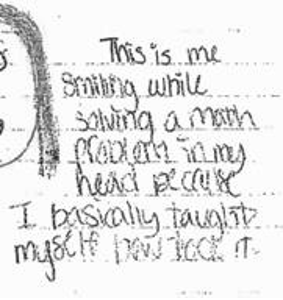
Participants who had a change in emotions as time passed indicated they loved math but due to an experience where they became frustrated, their love for it decreased (see Figure 6). This writing shows a change in a student’s emotions towards math. As math was “ruined” for this participant by a negative experience with a teacher.

Others showed the opposite, as they went from hating math to liking it. From this group we were able to identify another group – participants who were hopeful. Participants in this group said, “I CAN DO IT,” “whiteboards help me understand,” and “I will one day teach it.” These participants hope for a better understanding of math, signifying a belief that their math ability will experience future growth (see Figure 7).

Written Descriptions and Portrait Relationships
The writing corresponded to what the self-portrait showed in about half (57.7%) of the participants. For example, a participant drew themselves doing math surrounded with question marks and with a perplexed face and wrote that math was confusing. Fifteen participants (28.9%) provided writing that aided the understanding of the picture. For these participants, it was difficult to tell their feelings towards math with just the picture alone and the writing allowed for a fuller clarification. An example of this is a participant who drew themselves solving a problem and accompanied it with a caption explaining math came easy for them. Without the words, it would have been difficult to decipher how they were feeling.
In Figure 8, a participant drew herself smiling while doing work. The writing besides it shows their hope to become better in math so that they can improve their ability to teach it. This enthusiasm and growth mindset is evident in their writing but could not have been derived by their image alone.
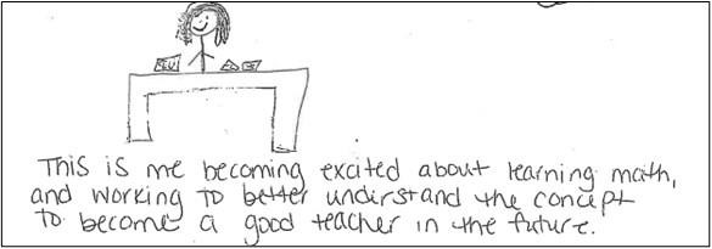
One participant provided a picture whose writing and picture did not relate. This participant showed herself sitting at a desk attempting to solve a problem, with a thought bubble that mentions that although it would take them a while to solve the problem, they will sit there until they get it. While this illustration showed the participant struggling, it also showed their determination to succeed. The writing was puzzling because while the participant tried to keep a positive outlook, they still labeled math as their weakness. This participant said “Looking back, I came to the realization that I started to have a growth mindset. I took the negative thoughts and would tell myself that if I did not start to have faith in my work, I would not retain any more information. Today, math is my weakness, however, I have learned not to hate it.” (See Figure 9).
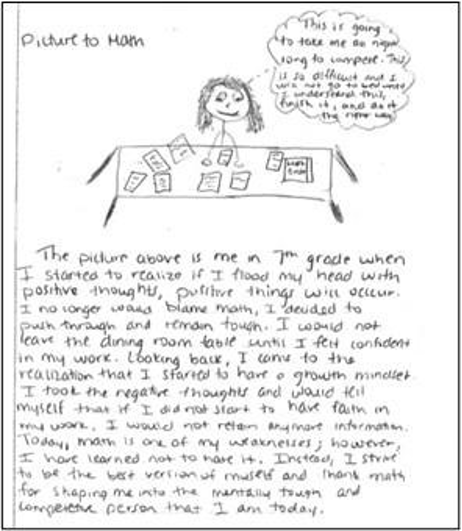
Combining interpretations of the drawing, the words that accompanied the drawing, and the placement of themselves and others in the picture, resulted in seven math perspectives: indifference towards math (19.2%), hopeful (9.6%), anxiety (9.6%), love for math (19.2%), frustration (30.8%), positive outlook caused by a positive change (5.8%), and a negative outlook caused by a negative experience (5.8%). Indifference towards math was shown in pictures of participants doing the work without any negative or positive emotions. This may indicate that these participants may not have faced any positive or negative critical experiences that led them to feel strongly about mathematics. Pictures that illustrated a hopeful relationship included a mention of a negative outlook on math but also a willingness to try different strategies to better themselves to become great teachers (see Figure 8). This motivation to become a great teacher seems to have shifted their math perspective. Participants who experienced confusion and frustration drew pictures of being unable to solve a problem. Participants who had a negative relationship with math often attributed it to a negative experience with a teacher, a class, or the subject in general. Participants who showed a positive relationship with math illustrated a positive experience they had with the subject or a teacher. Participants who showed anxiety indicated that math caused a negative impact and raised their anxiety level, signifying the perception of distress related to math (see Figure 10).
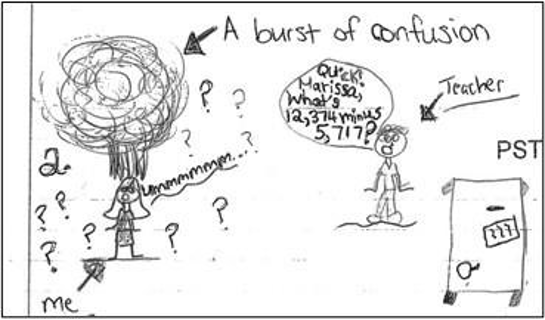
Participants who displayed a love for math used words to describe their mathematical journey such as “love,” “passion,” “enjoy,” and “yay” (see Figure 11).

Setting
Where participants chose to place themselves learning mathematics and what they included in the background of the portraits was also investigated. Most participants chose experiences that happened in the classroom. These depictions included objects in the drawing being enlarged (clocks, white boards, math work or posters), different math concepts, classmates, and teachers. Certain objects being enlarged may indicate how that object was a stressor as the main focus of the picture. For example, one showed a large math textbook with a tiny participant standing next to it looking confused and sad (see Figure 1). The size of the book and participant may indicate that this participant’s relationship with math was unequal in nature, with the amount of math to know and do making them feel small and confused.
Positive portraits showed participants smiling, lightbulbs above the participants head, hearts, the participant sitting in front of the class, and the teacher being present. In one portrait, there were other participants surrounding them talking to one another and being distracting. This participant may be showing that they were not affected by all the distractions going on in the room. Positive portraits such as these indicate that the participants were actively engaged and thinking about the math lesson (see Figure 12).
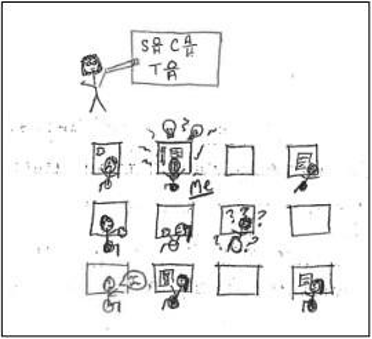
Some participants drew non-classroom settings that had similar aspects to the classroom settings. Participants placed themselves at desks or tables, in their bedroom, or drew one object that symbolized their experience. One of the drawings showed the person sitting on their bed with a large moon outside the window, clocks everywhere, papers spread about, and the participant looking sad and tired. This drawing shows that this participant worked on their math homework all night and still felt confused. One participant chose to draw their brain “on math” (see Figure 13). The brain drawing and captions may indicate a love and hate relationship with math.
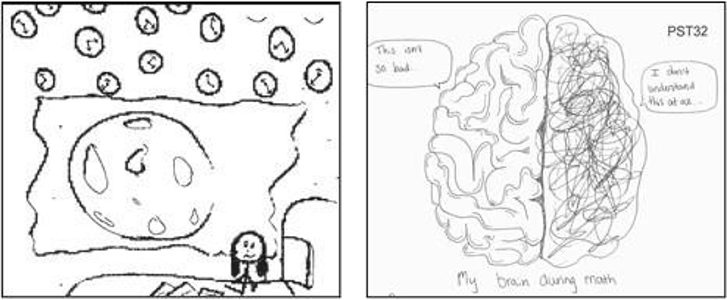
Change over Time
Many participants drew a time span of mathematics learning, indicating a change that occurred. Some participants’ relationships with math started off positive and became negative later in their academic experience. For example, one participant expressed that math came easy to them throughout elementary and middle school but when they were introduced to trigonometry in high school, they became discouraged and less confident about math (see Figure 14, left). The participant appears to be smiling and has a text bubble above their head saying, “easy!” while they review multiplication. The other picture shows a similar setting, but the subject is trigonometry. The participant’s facial expression changes from smiling to sad and the text bubble says, “Ugh!”
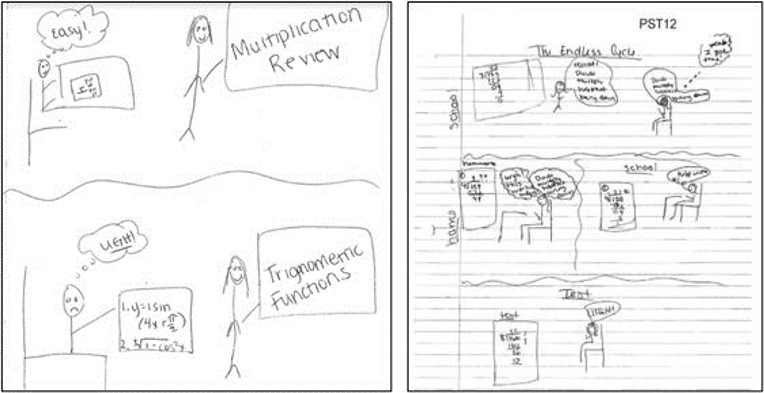
One participant chose to draw their math journey through the lens of learning long division (see Figure 14, right). Their drawings showed they lacked understanding with long division and labeled their drawing an “endless cycle”. The participant illustrates struggling with division in school, at home, and during a test. The way the participant portrayed their experience with long division indicates that repeated episodes of frustration may have a negative impact on an overall relationship with mathematics.
Discussion
The results show that PSTs’ self-portraits in this study illustrate negative emotions and experiences more often than positive and neutral experiences. The emotions that were depicted in the self-portraits were primarily negative including confusion, anger, and sadness. Positive and neutral emotions, such as “happy” and “focused,” were less prevalent. The portraits showed the ways in which math can be intimidating and cause stress for many students. We believe it is increasingly important for PSTs to understand their own relationship with math to avoid imparting possible negative emotions or attitudes on their future students. This needs to occur before PSTs can make math instruction relevant, inclusive, and engaging.
The analysis of the self-portraits indicated that relationships with math and perceived ability to perform math can be formed from an early age, as many PSTs drew themselves as young children. One such relationship that emerged is math anxiety. Math anxiety has been defined as the tension and anxiety that have a negative impact on the ability to solve mathematical problems (Mutlu, 2019). The portraits showed that PSTs continue to hold onto their own math anxiety, even after time has passed. Part of a PST’s math-anxiety dilemma can be attributed to prior experiences with their own teachers, lack of subject knowledge, and inadequate teacher preparation programs (Schubert, 2019). When math anxiety is not addressed for PSTs, they may feel overwhelmed and stressed in math methods courses. Approaches to addressing students’ math anxiety include increasing students’ math skills, increasing student engagement with math, and instruction that aims to develop a growth mindset which views failure and struggle as a means to improvement (Ramirez et al., 2018).
While many of the relationships were characterized as being negative and filled with anxiety, others were seen as more positive. These relationships resulted in students feeling confident in their ability to perform math. However, on occasion, these relationships demonstrated an inflated sense of self-assurance. Some participants believed that they had a natural ability to perform math which illustrated a fixed mindset. This view reinforces an overarching theme to both positive and negative relationships in the study: that despite knowing that growth is possible, the idea that one may be a “math person” or not often prevails.
One significant and influential factor is the other people participants included in their portraits. Teachers were often drawn to be larger than the participants and students. Teachers were also usually drawn smiling, saying something at a board or in front of the class, or directing a question to be answered. Very rarely were the teachers drawn frowning, with angry expressions, or as expressionless. However, several of the class peers included in drawings had negative or conflicting expressions, such as smiling with furrowed brows. Often, other classmates were drawn smiling and expressing an answer to a problem, while the PST was quietly imploding. This illuminates the isolation a student can feel when others are perceived as understanding the lesson, and the student believes they are the only person in the class who is struggling. Interestingly, all the portraits in this study showed students working in isolation, in a whole-class teacher-directed lesson, or with a teacher. We did not see evidence of a participant working in a group or collaborating during episodes of math learning.
A common theme among the participants was the motivation to learn due to a teacher’s enthusiasm and instructional strategies. This shows how important it is for teachers to remain excited about math and to spread positive feelings to others during math lessons. Teachers must encourage their students to be intrinsically motivated, to want to participate because the activity or topic is something that interests the student, as opposed to being extrinsically motivated (Gojak, 2013). A teachers’ pedagogical decisions and disposition towards mathematics have a large and lasting impact on students. Therefore, what happens during math lessons should be carefully analyzed to ensure that all students can access the learning and feel supported in the process of doing so.
Math instruction that is interdisciplinary, hands-on, and innovative promotes intrinsic motivation. Teachers can also incorporate stories, music, and art into math to provide a wider lens on how math intersects with other subjects (Larson & Rumsey, 2018). To accommodate multiple perceptions of math content, teachers can be prepared to offer more than one strategy or solution path in math lessons (Small, 2019). Students can be encouraged to use a strategy that makes sense, rather than adopt a single approach that they might not understand yet (Boaler, 2016). Children often see math in more than one way, and teachers can capitalize on their mathematical insights and creativity to build a richer and more inclusive learning experience. It’s the author’s experience that these approaches will help convince students that they are “math people.”
Student Researcher Reflections
Being both participants and researchers, we were able to closely examine our own relationships with math with more honesty. We want to foster a growth mindset in our future students so that they can view failures, not as roadblocks, but as steppingstones. We realized that the way we speak, act, and teach math sends messages to our students. We will have students who have vastly different experiences from us and some who might be experiencing similar reactions from our own time as math students. This research increased our ability to understand our own math-learning journey and that of others. We believe this will be immensely helpful to us as future educators.
Each of us brought a different perspective to the research. One of us experienced success all through school in mathematics and feels confident in their ability to teach and learn math. Another of us is a math-learner with significant dyscalculia, who is on a personal journey to support other students like them to learn to do math well. Our third researcher takes a pragmatic approach to math and recognizes its usefulness in the world but remains neutral about the subject. Through this research, we all learned that our decisions as future teachers of math matter. We recognize we must build a math community that accounts for all learners. We know we must pay close attention to the perspectives and relationships we are helping our students build with mathematics. We reflect that there is a need to facilitate deeper connections and understandings of mathematics to teach math well. However, we feel that in our teacher preparation experience, only a handful of math courses for pre-service teachers may not truly provide the time and preparation needed.
Study Limitations
We recognize that the study participant size is small (n = 52) and does not reflect a wide diversity either in gender (51 female, 1 male), or race (participants are mostly white) which limits the opportunity to generalize these findings to a larger population of PSTs. The location of the institution is in a rural region of a northeastern state, and this contributed to the population demographic. Moreover, many of the students come to this university from small and mostly homogeneous towns to attend. However, the results in this smaller population mirror what research indicates about PSTs’ math anxiety and concern about teaching mathematics in school (McGlynn-Stewart, 2010; Schubert, 2019; Stoehr & Olson, 2015). We recommend further investigation into a wider population to help broaden our understanding of this phenomenon. We believe this will increase the quality of math education instruction in teacher education institutions and for PSTs’ future students.
Conclusion
The assignment to “Draw a picture of yourself learning math” allowed for an examination of how experiences, emotions, and reactions to learning math impact PSTs. Through this process, it has become clear that the prevalence of math anxiety, sources of motivation, and the instructional practices present in classrooms can have residual effects on PSTs. PSTs who had more negative experiences, emotions, relationships, and perspectives towards mathematics may worry the most about their ability to teach mathematics. We suggest it is essential for PSTs to examine their past experiences learning math, and creating self-portraits was an effective way to begin this conversation. In our math methods course, we were asked to share our portraits and the stories behind them with our classmates. This provided an opportunity to develop an understanding about the connections between mathematics instructional strategies and the lingering impacts (both positive and negative) which they can have. Moreover, the students in our class recognized the variation in experiences, learning differences, and the very real math anxiety often exhibited by their peers. Drawing self-portraits and providing opportunities for discussion and reflection can help PSTs approach mathematics teaching and learning in a more comprehensive manner. PSTs may come to better understand themselves and others as learners of mathematics, and thereby remain open to learning new strategies and practices in methods courses in teacher preparation programs. This will be a benefit to all stakeholders in the math learning process.
While we cannot change past experiences, we can examine them, and use this information to make sound pedagogical choices in our own classrooms. The PSTs’ self-portraits illustrated the complexity of emotions and reactions that students can experience while learning mathematics. We recommend that teacher educators take similar opportunities to aid PSTs in recognizing, and often renegotiating, a past relationship with math. This may lessen anxiety and self-doubt, and help PSTs grow in knowledge and capacity to teach math well in their future classrooms.
References
Boaler, Jo. (2016) Mathematical mindsets: Unleashing students’ potential through creative math, inspiring messages, and innovative teaching. Jossey-Bass & Pfeiffer Imprints.
Brady, P., & Bowd, A. (2005). Mathematics anxiety, prior experience, and confidence to teach mathematics among pre‐service education students. Teachers and Teaching, 11(1), 37-46. DOI: https://doi.org/10.1080/1354060042000337084
Cappello, M., Wiseman, A. M., & Turner, J. D. (2019). Framing equitable classroom practices: Potentials of critical multimodal literacy research. Literacy Research: Theory, Method, and Practice, 68, 205-225. DOI: https://doi.org/10.1177/2381336919870274
Corbin, J., & Strauss, A. (2014). Basics of qualitative research: Techniques and procedures for developing grounded theory (4th edition). Thousand Oaks, CA: Sage.
Costello, D. (2020). Linking literacy and math: Strategies to support a writing process in mathematics. Ontario Mathematics Gazette, 58(4), 23–26.
Du, Y., Xie, L., Zhong, J. A., Zou, H., Law, R., & Yan, X. (2019). Creativity fostering teacher behavior on student creative achievement: Mediation of intrinsic motivation and moderation of openness to experience. School Psychology International, 40(5), 525–542. https://doi.org/10.1177/0143034319868271
Gojak, L. M. (2013, March 7). Motivation matters! National Council of Teachers of Mathematics. Retrieved from https://www.nctm.org/News-and-Calendar/Messages-fromthe-President/Archive/Linda-M_-Gojak/Motivation-Matters!/
Hadley, K.M. & Dorward, J. (2011). The relationship among elementary teachers’ mathematics anxiety, mathematics instructional practices, and student mathematics achievement. Journal of Curriculum and Instruction, 5(2), 27-44.
Karunakaran, M. S. (2020). Opportunities to decrease elementary prospective teachers’ mathematics anxiety. Mathematics Enthusiast, 17(2-3), 469-492. Retrieved from: https://scholarworks.umt.edu/tme/vol17/iss2/6/
Larson, L. C., & Rumsey, C. (2018). Bringing stories to life: Integrating literature and math manipulatives. The Reading Teacher, 71(5), 589–596. https://doi.org/10.1002/trtr.1652
McGlynn‐Stewart, M. (2010). Listening to students, listening to myself: Addressing pre‐service teachers’ fears of mathematics and teaching mathematics. Studying Teacher Education, 6(2), 175–186. DOI: https://doi.org/10.1080/17425964.2010.495898
Mutlu, Y. (2019). Math anxiety in students with and without math learning difficulties. International Electronic Journal of Elementary Education, 11(5), 471–475. https://doi.org/10.26822/iejee.2019553343
Rapp, W. H. (2009). Avoiding math taboos: Effective math strategies for visual-spatial learners. Teaching Exceptional Children Plus, 6(2), 2–12. Retrieved from: https://files.eric.ed.gov/fulltext/EJ875427.pdf
Ramirez, G., Shaw, S. T., & Maloney, E. A. (2018). Math anxiety: Past research, promising interventions, and a new interpretation framework. Educational Psychologist, 53(3), 145–164. https://doi.org/10.1080/00461520.2018.1447384
San Giovanni, J., Katt, S., & Dykema, K. (2020). Productive math struggle: A 6-point action plan for fostering perseverance. Corwin Mathematics.
Schubert, E. (2019). Stopping the cycle of math anxiety: Recommendations for teachers and schools. Delta-k, 55(2), 15-24.
Small, M. (2019). Understanding the math we teach and how to teach it (k-8). Stenhouse Publishers.
Spikell, M. (1993). Teaching mathematics with manipulatives: A resource of activities for the K-12 teacher. New York: Allyn and Bacon.
Stoehr, K., & Olson, A. (2015). Can I teach mathematics? A study of preservice teachers’ self‐efficacy and mathematics anxiety. In T. G. Bartell, K. N. Bieda, R. T. Putnam, K. Bradfield, & H. Dominguez. Proceedings of the 37th annual meeting of the North American Chapter of the International Group for the Psychology of Mathematics Education (pp. 948–951). Michigan State University.
Tobias, S. (1993). Overcoming math anxiety. New York: W. W. Norton & Company.
Yu, R., & Singh, K. (2018). Teacher support, instructional practices, student motivation, and mathematics achievement in high school. The Journal of Educational Research, 111(1), 81–94. https://doi.org/10.1080/00220671.2016.1204260
Zazkis, D. (2015). Monsters, lovers, and former friends: Exploring relationships with mathematics via personification. For the Learning of Mathematics, 35(33-38).
